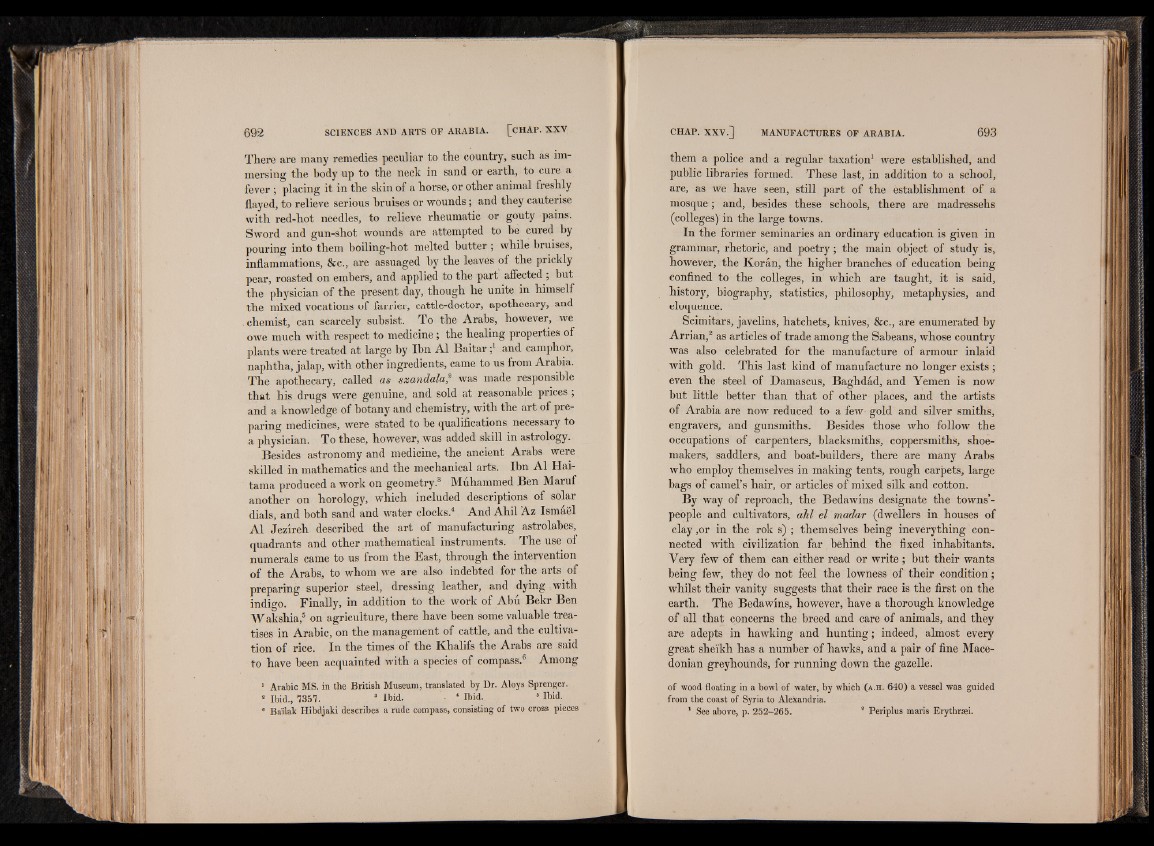
There are many remedies peculiar to the country, such as immersing
the body up to the neck in sand or earth, to cure a
fever ; placing it in the skin of a horse, or other animal freshly
flayed, to relieve serious bruises or wounds ; and they cauterise
with red-hot needles, to relieve rheumatic or gouty pains.
Sword and gun-shot wounds are attempted to be cured by
pouring into them hoiling-hot melted butter ; while bruises,
inflammations, &c., are assuaged by the leaves of the prickly
pear, roasted on embers, and applied to the part affected ; but
the physician of the present day, though he unite in himself
the mixed vocations of farrier, cattle-doctor, apothecary, and
chemist, can scarcely subsist. To the Arabs, however, we
owe much with respect to medicine ; the healing properties of
plants were treated at large by Ibn A1 Baitar j1 and camphor,
naphtha, jalap, with other ingredients, came to us from Arabia.
The apothecary, called as szandala,2 was made responsible
that his drugs were genuine, and sold at reasonable prices ;
and a knowledge of botany and chemistry, with the art of preparing
medicines, were stated to be qualifications necessary to
a physician. To these, however, was added skill in astrology.
Besides astronomy and medicine, the ancient Arabs were
skilled in mathematics and the mechanical arts. Ibn A1 Hai-
tama produced a work on geometry.3 Muhammed Ben Maruf
another on horology, which included descriptions of solar
dials, and both sand and water clocks.4 And Ahil Az Ismâël
Al Jezireh described the art of manufacturing astrolabes,
quadrants and other mathematical instruments. The use of
numerals came to us from the East, through the intervention
of the Arabs, to whom we are also indebted for the arts of
preparing superior steel, dressing leather, and dying with
indigo. Finally, in addition to the work of Abu Bekr Ben
Wakshia,5 on agriculture, there have been some valuable treatises
in Arabic, on the management of cattle, and the cultivation
of rice. In the times of the Khalifs the Arabs are said
to have been acquainted with a species of compass.6 Among
1 Arabic MS. in the British Museum, translated by Dr. Aloys Sprenger.
s Ibid., 7357. *. Ibid. • 4 Ibid. 5 Ibid.
* Ba'flak Hibdjaki describes a rude compass, consisting of two cross pieces
them a police and a regular taxation1 were established, and
public libraries formed. These last, in addition to a school,
are, as we have seen, still part of the establishment of a
mosque; and, besides these schools, there are madressehs
(colleges) in the large towns.
In the former seminaries an ordinary education is given in
grammar, rhetoric, and poetry; the main object of study is,
however, the Koran, the higher branches of education being
confined to the colleges, in which are taught, it is said,
history, biography, statistics, philosophy, metaphysics, and
eloquence.
Scimitars, javelins, hatchets, knives, &c., are enumerated by
Arrian,2 as articles of trade among the Sabeans, whose country
was also celebrated for the manufacture of armour inlaid
with gold. This last kind of manufacture no longer exists;
even the steel of Damascus, Baghdad, and Yemen is now
but little better than that of other places, and the artists
of Arabia are now reduced to a few gold and silver smiths,
engravers, and gunsmiths. Besides those who follow the
occupations of carpenters, blacksmiths, coppersmiths, shoemakers,
saddlers, and boat-huilders, there are many Arabs
who employ themselves in making tents, rough carpets, large
bags of camel’s hair, or articles of mixed silk and cotton.
By way of reproach, the Bedawins designate the towns’-
people; and cultivators, ahl el madar (dwellers in houses of
clay,or in the rok s) ; themselves being ineverything connected
with civilization far behind the fixed inhabitants.
Very few of them can either read or write; but their wants
being few, they do not feel the lowness of their condition;
whilst their vanity suggests that their race is the first on the
earth. The Bedawins, however, have a thorough knowledge
of all that concerns the breed and care of animals, and they
are adepts in hawking and hunting ; indeed, almost every
great sheikh has a number of hawks, and a pair of fine Macedonian
greyhounds, for running down the gazelle.
of wood floating in a bowl of water, by which ( a .h . 640) a vessel was guided
from the coast of Syria to Alexandria.
1 See above, p. 252-265. ‘ Periplus maris Erythrsei.